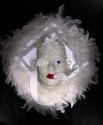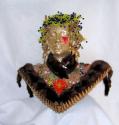
Learn foreign languages while watching your favorite YouTube videos!
The Language learning app is a handy set of tools that will help you improve your language skills by accessing subtitles, a built-in dictionary, and saving words and phrases you want to learn to revise.
Learning foreign languages will be an interesting and exciting experience for you!
Graziella Marchicelli, Ph.D
Fine Arts Curator
The Southern Alleghenies Museum of Art
The Surrealist inclination to aestheticize found objects and often juxtapose incongruent ones led to the experimentation of department store mannequins as art objects—a natural choice considering the mannequin's malleability. In the 1938 Exposition Internationale du Surrealisme, organized by Paul Eluard, Andre Breton and Marcel Duchamp at the Galerie Beaux-Arts, the Surrealists presented department store mannequins as apparitions d'etres-objets (phantom object-beings).1 Andre Masson's female mannequin attracted the most attention. "Her head is imprisoned in a bird cage...her mouth masked, with a pansy directly over the opening...She cannot speak; she is entrapped even as she is decorated, wearing at once too much and too little, dressed up and dressed down, naked and rendered mute, added to and subtracted from, but most of all entrapped"2 The female mannequin was the Surrealists' readymade plaything—tamed, silent and submissive.
The female mannequin has also fascinated Jo Owens Murray. A self-taught artist, Murray received a Bachelor of Arts in art history from Rosemont College, Pennsylvania in 1993, and managed Rosemont College's Women's Center until she decided to become a full time artist. Born in Durham, North Carolina, Murray left home at age nineteen, eventually settling in Pennsylvania where her family roots lie.
Although Murray started her career as a photographer, she was drawn to assemblage sculpture by way of experiments with various materials and fabrics. Murray's assemblage sculptures, which she calls "the girls", are unique and exceptional examples of contemporary Surrealism, and her application of beads and jewels adhered to mannequins is a pioneering technique. Her sculptures are heavily encrusted with large, brightly colored beads, buttons, mirrors, costume jewelry, plastic flowers, feathers, bridal veils and birdcages.
Murray defies the current art world's tendency to pad each work with profuse rhetoric or lengthy statements. Although she states that her work is about specific concerns regarding women, she makes a point of stepping back and allowing room for viewer interpretation. Murray's beaded sculptures prompt questions about beauty, femininity, identity, loss, grief and redemption. Her sculptures explore myths about women. Journalist Burton Wasserman wrote that Murray's work has "deeply rooted layers of personal memory, thought and feeling, joined with reflections on the various roles played by women in society, past and present."3 About herself, Murray says, "My sculptures reflect my own upbringing as a young girl, my fantasies combined with the realities of today."
Biography: Burton Wasserman
Art Critic, NJ
Jo Owens Murray has an uncanny knack for joining objective awareness with subjective impulses in order to shape artworks rich with sensitive human feeling and significant social commentary. She has developed an idiom entirely her own, one tree of debt to the style of any provincially academic art professors. Combining external sensory reality with suggestions for expressive form drawn from a deep reservoir of intuitive ideas, she makes sculpture that reflects what she has learned, both from her own life and from the accumulated interaction she has experienced with others in the world at large. The reach she brings to her unique vocabulary extends from the logical and the rational to a mysterious well spring of subconscious creative urges located within the substrata of her center most sinews.
Murray is well known in the Delaware Valley for the images she conceives with frequently hollow styrofoam figure forms that are covered with beads, bangles, brooches and buttons galore. For many years she has been hoping for a chance to present her work in New York City. That opportunity has finally come. Now, she is in the Ward-Nasse Gallery, 178 Prince St. New York
At first glance, Murray's doll forms may look rather naive. But, like the Jo Owens Murray has an uncanny knack for joining objective awareness with subjective impulses in order to shape artworks rich with sensitive human feeling and significant social commentary. She has developed an work of Paul Klee, Joan Miro and Joseph Comell, her sculpture is alive with subtle nuances of original iconography and discarded odds and ends taken from hither and yon. They have all been turned into inseparable parts of exquisitely mysterious, daringly inventive passages of poetic form in three dimensions.
Country: United States
E-mail: artbyjo@verizon.net
Site: ARTBYJO




